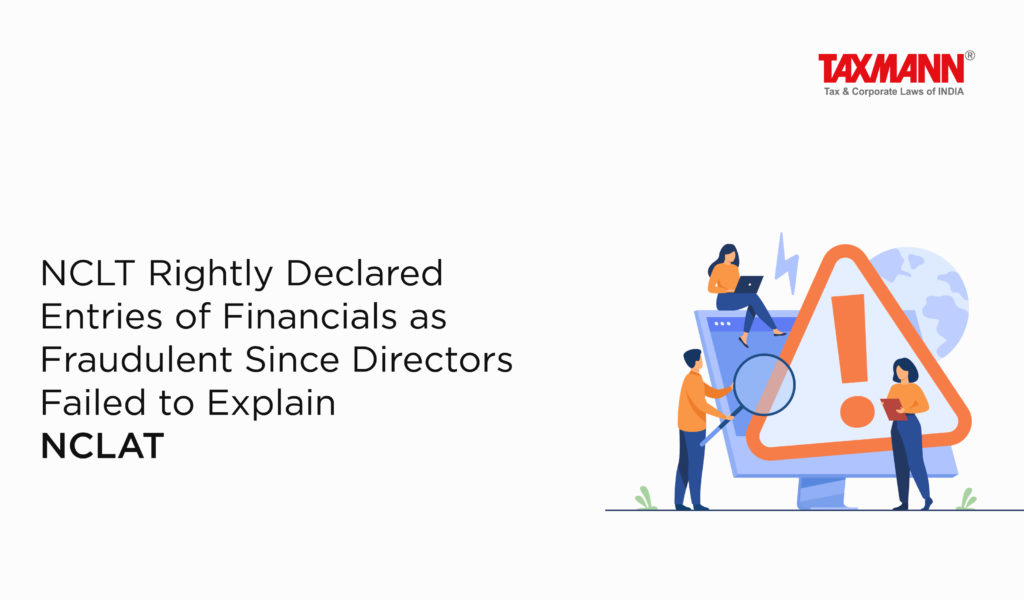NCLT Rightly Declared Entries of Financials as Fraudulent Since Directors Failed to Explain | NCLAT
- Blog|News|Insolvency and Bankruptcy Code|
- 2 Min Read
- By Taxmann
- |
- Last Updated on 22 August, 2023

Case Details: Shibu Job Cheeran v. Ashok Velamur Seshadri, Liquidator of Archana Motors Ltd. - [2023] 152 taxmann.com 634 (NCLAT-Chennai)
Judiciary and Counsel Details
-
- M. Venugopal, Judicial Member & Naresh Salecha, Technical Member
- Dr K.S. Ravichandran, PCS & Ms S. Manjula Devi, Adv. for the Appellant.
- S. Sathiyarayanan, Adv. & Ms D. Pavithra, Adv. for the Respondent.
Facts of the Case
In the instant case, the liquidation process was initiated against the corporate debtor by the Adjudicating Authority (NCLT) and the respondent was appointed as the liquidator. The respondent, while examining the balance sheets of the corporate debtor discovered certain entries that appeared to be fictitious.
Consequently, the respondent filed an application u/s 66 of the IBC against the appellants, who were suspended directors of the corporate debtor. This action was taken before declaring such entries to be fraudulent transactions.
The NCLT vide the impugned order agreed to the same. Thereafter, an appeal was made to the National Company Law Appellate Tribunal (NCALT) against the order passed by the NCLT.
The appellants contended that the loss of books of account, data and assets due to a flood had prevented them from providing all necessary information to the respondent. They also refuted the allegation regarding the misuse of trade receivables, which were considered assets from their customers.
It was noted that adequate opportunities were given to the appellants to provide details of their assets, locations and copies of the assets register of fixed assets. However, the appellants failed to do so.
NCLAT Held
The NCLAT held that, since the appellants had not turned out to be clean in their explanations, they could not avoid their responsibilities towards non-available or non-verifiable assets amounting to Rs. 21.37 crores as shown in the balance sheet. Thus, these assets were deemed to be fictitious in nature and appeared to have been created in the books of account, with the intent to defraud creditors.
Therefore, there was no error in the impugned order passed by the NCLT. Accordingly, the appeal was to be dismissed.
List of Cases Reviewed
-
- Ashok Velamur Seshadri, Liquidator of Archana Motors (P.) Ltd. v. Shibu Job Cheeran [2023] 152 taxmann.com 633 (NCLT – Kochi) (para 55) affirmed [See Annex].
List of Cases Referred to
-
- Anuj Jain v. Axis Bank Ltd. [2020] 114 taxmann.com 656 (SC) (para 20).
Disclaimer: The content/information published on the website is only for general information of the user and shall not be construed as legal advice. While the Taxmann has exercised reasonable efforts to ensure the veracity of information/content published, Taxmann shall be under no liability in any manner whatsoever for incorrect information, if any.

Taxmann Publications has a dedicated in-house Research & Editorial Team. This team consists of a team of Chartered Accountants, Company Secretaries, and Lawyers. This team works under the guidance and supervision of editor-in-chief Mr Rakesh Bhargava.
The Research and Editorial Team is responsible for developing reliable and accurate content for the readers. The team follows the six-sigma approach to achieve the benchmark of zero error in its publications and research platforms. The team ensures that the following publication guidelines are thoroughly followed while developing the content:
- The statutory material is obtained only from the authorized and reliable sources
- All the latest developments in the judicial and legislative fields are covered
- Prepare the analytical write-ups on current, controversial, and important issues to help the readers to understand the concept and its implications
- Every content published by Taxmann is complete, accurate and lucid
- All evidence-based statements are supported with proper reference to Section, Circular No., Notification No. or citations
- The golden rules of grammar, style and consistency are thoroughly followed
- Font and size that’s easy to read and remain consistent across all imprint and digital publications are applied



 CA | CS | CMA
CA | CS | CMA
